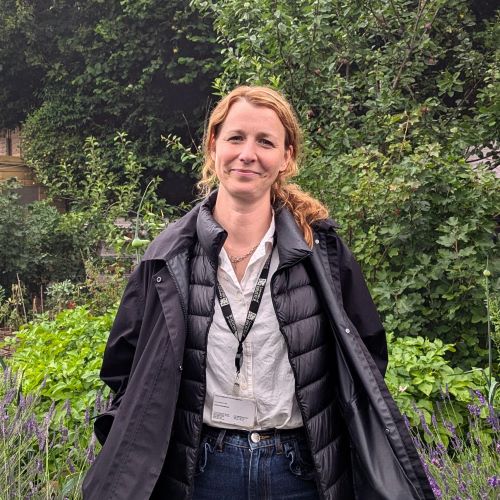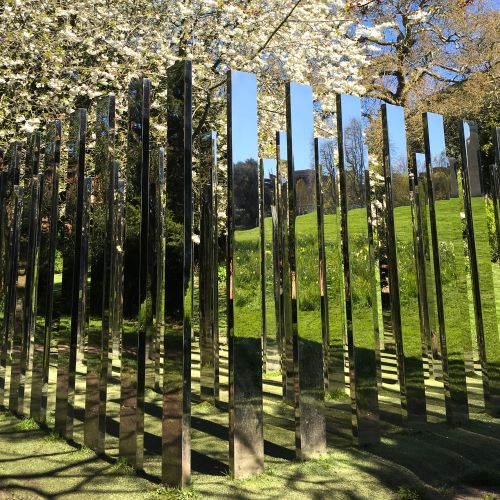Get to know the Public Art Team!
We had a chat with Martha Crean, our Public Art Coordinator, to get an insight into what the team gets up to and the exciting projects they have coming up!
What does the Public Art team get up to?
Public Art is a small team consisting of me as the Coordinator, since 2020, and then I work with Nicki Kent who is the administrator for the team. Our work is very varied, covering several strands of work, but the focus is on delivering the University Public Art Strategy that was drawn up in 2019 to support the two public art projects the University is now embarking on. The first project, which is currently well underway, is for the new Temple Quarter Enterprise Campus (TQEC). The second is the New University Library. We have been working with the Contemporary Arts Society to select and support artists working on these projects with us. There have already been two artists residencies in relation to the TQEC project, plus three confirmed commissions which we will be managing the delivery of.
We’ve also been building and maintaining a website for current Public Art projects and which acts as a digital archive for the existing collection. There are currently nine public artworks in the collection, developed over the last 15 years, which you can find primarily on the Clifton Campus and can visit all year round. Alongside these permanent features, the Public Art team has worked on various projects over the years. From developing podcasts to assisting in filming to supporting creative engagement at the Little Library, which is part of the University’s Barton Hill Micro-Campus.
Facilitating relationships between artists and academics is a very exciting part of what we do. We support the artists through their navigation of their commission with the university – many artists either haven’t worked with an academic institution before or haven’t worked with such a large institution, so there are always some new contexts or challenges to work through. But also, many academics haven’t worked with artists before! So we have an on-going project of developing a set of art guidelines which are all about supporting colleagues in commissioning meaningful projects. Overall, we work to keep all the on-going art projects agile, collaborative, considered, and public-facing.
Why does a University have a public art collection?
The collection has come about for a variety of reasons. Some pieces celebrate the construction of new buildings, sometimes they are created by an artist in collaboration with academics and the work they are doing with the university, some are donated by an artist. With donations it is usually the case that the artist has deemed the university an appropriate place for their work to be housed, as is the case for Luke Jerram’s Palm Temple. Public artworks heavily contribute to placemaking and a sense of belonging, they add a lot to our relationship with a space.
Our definition of what public art is currently expanding, with an emphasis being put on creating experiences and cultural exchange through participation. The current collection includes quite a few traditional sculptural mediums, which are still important, and act somewhat as a living archive.
Going forward, as seen in the TQEC project, the purpose of the university’s public art collection will be; to inspire, to interrupt the day to day journeys through the campus, to hopefully open our eyes to something new, and to help students, staff, and the public feel welcomed and part of a university space. Through taking a new creative angle with artist commissions we will be creating new experiences and cultural exchanges. An example of this can be seen in the piece we are developing with the artist Ellie Shipman and the Dhaqan Collective, a feminist art collective of Somali women. It is a textile-based artwork commissioned for inside TQEC which will act as a curtain for a discussion zone on the ground floor. The piece will be framed thematically with the history of the site, with its many interesting layers from its industrial histories which create the sense of place today.
Do you have a favourite piece in the collection?
It is probably Follow Me by Jeppe Hein. I love watching people exploring it, and it is so beautifully integrated into the landscaping of Royal Fort Gardens, it’s a really fun piece. But I do also do really like Hollow, by Katie Paterson, which is made up of thousands of trees both from across the globe and throughout history. Both pieces were carefully placed within Royal Fort, and both add to the importance of the gardens as a whole – offering a public haven within a built up area.
How can people find out more about the University of Bristol’s public art collection?
We have recently launched an Instagram account with the aim of connecting what we are doing with new audiences, and to provide a more informal insight into what’s going on over the next two years. There is our What’s On blog, the intention of which is to centralize how artists are commissioned by or work with the university. One of our aims at the moment is to raise awareness of the commissioning guidelines for university colleges to work with artists in a meaningful way. To help with considering all the aspects of an artist’s commission, from a really small film commission to an academic collaboration which takes many months. We have our mailbox public-art@bristol.ac.uk so do send us any questions you may have there!

